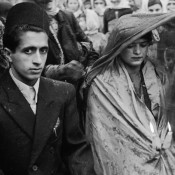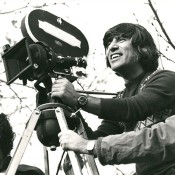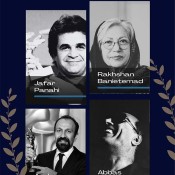Title
Author
The Portray of Iranian Women Athletes and Fans in the Cinema
In this article, I examine four movies, Offside, Cold Sweat, Hair, and Orca, to discuss how these movies address several central themes in women’s sports in Iran, including gender segregation in sports spaces, the socio-cultural…
The Anthropological Unconscious of Iranian Ethnographic Films: A Brief Take
Ethnographic filmmaking—defined as making films that represent one culture to another or to itself—emerged in Iran in the 1960s, driven by many factors, such as rapid modernization and the resulting population displacements and psychic and…
A Critical Overview of Bahrām Bayzā’ī’s Dramatic and Cinematic Oeuvre
Introduction In this entry, I trace the trajectory of Bahrām Bayzā’ī’s creative impulse and examine his oeuvre to offer an analytical overview of his aesthetic and thematic concerns and innovations. Before embarking on my chronological…
Screening Love: The Forbidden in Rakhshān Banī-i‛timād’s Nargis
Before the narrative even begins, Rakhshān Banī-i‛timād’s Nargis (Nargess) of 1992 directly engages the theme of love. As the film opens accompanied by the melodic score, a close-up of a conventional bride and groom figurine…
Asghar Farhādī
Asghar Farhādī was born in 1972 in Humāyūnshahr, also known as Sidah (now called Khumaynīshahr), on the outskirts of Isfahan. He gravitated towards theater and film at an early age despite having no obvious family…
The International Reception of Iranian Cinema
Introduction Iranian cinema entered the European film festival scene in the 1960s. The first Iranian film to screen at Cannes was Mostafa Farzaneh’s…
Internet Cinema: A Cinema of Embodied Protest
This article is about an emergent form of cinema in whose production and propagation most of us have participated in one way or another. I will concentrate on its manifestation in Iran around the political…
Seventeen (17) Days to Execution
Director: Hūshang Kāvūsī Year of Release: 1956 Screenplay: Hūshang Kāvūsī Source Material: Phantom Lady, a novel by Cornell Woolrich (1942) Music: Vārtān Āzārīyān Cinematography: Mahdi Amīr Qāsim Cast: Nāsir Malik-Mutī‛ī, Muhsin Mahdavī, Sūzān, Mahīn Mu‛āvinzādah,…
A
- Abbas Kiarostami| ‛Abbās Kīyārustamī| عباس کیارستمی
- Abbas Kiarostami’s Documentary Objects; Cinema’s Powers From Rolling Cans to Errant Footballs
- Abolhassan Davoodi/Abu Al-hasan Dāvūdī/ابوالحسن داوودی
- Accented Cinema: Transnational Storytelling in Makhmalbaf’s Works and Their Global Impact
- Affective Listening
- Afsānah Bāyigān | Afsaneh Bayegan | افسانه بایگان
- Ahmad Reza Darvish/Ahmad Rizā Darvīsh/احمدرضا درویش
- Alireza Davood-Nejad/‛Alī Rizā Dāvūd-Nizhād/علیرضا داوودنژاد
- Ali Hatami | ‛Alī Hātamī | علی حاتمی
- Ali Hatami’s Delshodegan (1992)
- Alternative Cinema: A Cinematic Revolution Before the 1979 Revolution
- Amir Naderi/Amīr Nādirī/امیر نادری
- Apartment Dramas
- Apartment Dramas in Iranian Cinema after the Green Movement
- Arbi Hovhannisean | Ārbī Uvānisiyān | آربی آوانسیان
- Arby Ovanessian/Ārbī Uvānisīyān/آربی آوانسیان
- Art Cinema
- Asghar Farhadi and the Dubious Conscience of Post-Revolutionary Iran
- Asghar Farhadi | Asghar Farhādī | اصغر فرهادی
- Asghar Farhādī
- Aṣghar Farhādī
- Audacious Cinema: Transfiguration of ethical storytelling in Iran
- A Comparative Study Concerning The First Two Films Directed by Iranian Women
- A Critical Overview of Bahrām Bayzā’ī’s Dramatic and Cinematic Oeuvre
- A Dragon Arrives!
- A Dragon Arrives! (Azhdahā Vārid Mīshavad!)
- A Girl Walks Home Alone at Night (2014) by Ana Lily Amirpour
- A Historical Wound: The Role of Ta‘ziya as a theater-ritual in Iranian Cinema
- A Moment of Innocence | Nūn va guldūn | نون و گلدون
- A Party in Hell | Shab’nishīnī dar jahannam | شب نشینی در جهنم
- A Separation | Judāʾī-i Nādir az Sīmīn | جدایی نادر از سیمین
- A Silenced Historical Testimony
- A Simple Event (Yik Ittifāq-i Sādah)
- A Simple Event (1973)
B
- Bahman Farmanara
- Bahman Farmanara | Bahman Farmānārā | بهمن فرمان آرا
- Bahman Ghobadi | Bahman Qubādī | بهمن قبادی
- Bahram Beyzaei | Bahrām Bayzāyī | بهرام بیضائی
- Bashu, The Little Stranger (1986)
- Bashu, the Little Stranger| Bāshū gharībah-yi kūchak | باشو، غریبه کوچک
- Beehive | Kandū | کندو
- Behrouz Afkhami/Bihrūz Afkhamī/بهروز افخمی
- Behrouz Vossoughi
- Behrouz Vossoughi and The Failure of Rebelious Masculinity
- Brick and Mirror | Khisht va āyīnah | خشتو آیینه
- Bārān Kawsarī | Baran Kosari | باران کوثری
C
- Certified Copy
- Children of Heaven | Bachchah’hā-yi Āsmān| بچههای آسمان
- Children’s Cinema | Sīnima-yi Kūdak | سینمای کودک
- Children’s Films
- Cinematic Male-Female Relationships
- Cinematic Mise-En-Scène
- Cinema and sports in Iran | سینما و ورزش در ایران
- Cinema Dar Qāb Tambr
- Cinema Rex Fire
- Close Encounters of the Fifth Kind: An Analysis of Iranian Science Fiction
- Close Up | Kluz-āp | کلوزآپ
- Close-Up (1990)
- Close-Up (1990)
- Comic Movies
- Connections Between Indian and Iranian Cinema
- Crime Genre in Iranian Cinema
- Crime Thriller Genre
- Crimson Gold | Talā-yi surkh̄ | طلای سرخ
- Cult for Context: The Curious Case of Mārmulak
D
- Dariush Mehrjui | Dāryūsh Mihrjūyī | داریوش مهرجویی
- Death of Yazdgerd | Marg-i Yazdgird | مرگ یزدگرد
- Death of Yazdgird | مرگ یزدگرد
- Documentary Cinema
- Documentary Films
- Documentary Iran in The 1950s: Village Films, Akhbār-i Irān Series, & The Cold War Story of US Government’s Documentary Diplomacy
- Documenting Iran in the 1950s: Village Films
- Domestic Violence in Contemporary Iranian Cinema
- Doubt in Love; Reinterpreting Love in Two Films from Makhmalbaf’s Cinema: The Time of Love – 1991 and Sex & Philosophy – 2005
- Downpour | Ragbār | رگبار
- Drama Movies
- Dukhtar-i Lur (Īrān-i imrūz va Īrān-i dīrūz) | دخترِ لُر (ایران امروز و ایران دیروز)
E
- Early Cinema
- Ebrahim Golestan
- Ebrahim Golestan | Ibrāhīm Gulistān | ابراهیم گلستان
- Ebrahim Golestan: Pioneering Narratives in Iranian Cinema
- Ebrahim Hatamikia | Ibrāhīm Hātamīkīyā | ابراهیم حاتمی کیا
- Ebrahim Khan Sahafbashi
- Ekhrajiha | Ikhrājīhā | اخراجی ها
- Esmail Koushan | Ismāʻīl Kūshān | اسماعیل کوشان
F
- Fakhrī Khurvash | Fakhri Khorvash | فخری خوروش
- Farhad Ayish/Farhād Ā’īsh/فرهاد آئیش
- Farrokh Ghaffari
- Farrokh Ghaffari | Farrukh Ghaffārī | فرخ غفاری
- Farsi Movie | Fīlmfārsī | فیلمفارسی
- Farzānah Ta’īdī | Farzaneh Taidi | فرزانه تاییدی
- Farīmāh Farjāmī | Farimah Farjami | فریماه فرجامی
- Fereydoun Jeyrani/Farīdūn Jayrānī/فریدون جیرانی
- Fereydoun Rahnema Between Archaism and Modernism Iran’s Son is Unaware of His Mother
- Fereydoun Rahnema | Farīdūn Rahnamā | فریدون رهنما
- Fereydoun Rahnema’s Postmodernist Approach in Siavash in Persepolis
- Fereydun Gole
- Fereydun Goleh | Farīdūn Gūlah | فریدون گُله
- Filming Locations
- Filming Locations in Iranian Cinema Before The Revolution (1930-1979)
- Film Adaptations and Narrative Change in Persian Fiction
- Film Aesthetics
- Film Criticism
- Film Dubbing
- Film Dubbing Before 1979
- Film Music | Mūsīqī-i Fīlm | موسیقی فیلم
- Film Music | Mūsīqī’yah film | موسیقی فیلم
- Film Production at Kānūn-i Parvarish-i Fikrī
- Film Schools and Education
- Film-e Faakher
- Film-Farsi and Everyday Life: Popular Cinema and Modernity in Pre-Revolutionary Iran
- Forced Empathy and the Geopolitics of Memory in Bahman Ghobadi’s Films
- Forouzan (Parvin Kheirbakhsh) | Furūzān (Parvīn Khayrbakhsh) | فروزان (پروین خیربخش)
- Forouzan (Parvin Kheirbakhsh) | فروزان (پروین خیربخش)
- From Defense to Intervention: The Iran-Iraq War on Screen and the Evolution of Sacred Defense Cinema
- From Golden City to Felestin: The Onomastics of Cinema Halls in Tehran
- From Karkheh to Rhein| Az Karkhah tā Rāyn | از کرخه تا راین
- From Mehrin Negar to Tara: The Evolution of Female Protagonists in Bahram Beyzaie’s “The Snake King” (1966) and “The Ballad of Tara” (1978-9)
- From Mongols to Television and Cinema (The Mongols / Mogholha- Parviz Kimiavi)
- From The Lor Girl to Bride of Fire: Tribal Women in Iranian Cinema
- From “Golden City” to “Felestin”: The Onomastics of Cinema Halls in Tehran
- Furuzan
- Furūzān Bihrūz | Forouzan Behrouz | فروزان بهروز
- Fātimah Mu‛tamid’āryā | Fatemeh Motamed-Arya | فاطمه معتمدآریا
- Fīlm-i Fākhir, the “Magnificent Productions,” or the “Islamic Blockbusters“ of Mahmūd Ahmadīnizhād’s Second Presidential Term
G
H
- Hadīyah Tihrānī | Hedieh Tehrani | هدیه تهرانی
- Haji Agha, the Cinema Actor | Hājī Āghā Āktur-i Sīnamā | حاجیآقا اکتور سینما
- Hamid Nematollah/Hamīd Nimatallāh/حمید نعمت الله
- Hamid Reza Ashtianipoor/Hamīd Rizā Āshtīyānīpūr/حمیدرضا آشتیان پور
- Hamoun by Dāriūsh Mehrjū’ī
- Hamoun | Hāmūn| هامون
- Hamīdah Khayrābādī | Hamideh Kheirabadi | حمیده خیرآبادی
- Hasan, the Bald | Hasan-Kachal | حسن کچل
- Hauntologies of The Present: Notes on Politics of Friendship in Férydoun Rahnéma’s Modernism
- Hingāmah Ghāzīyānī | Hengameh Ghaziani | هنگامه قاضیانی
- Home in Cinema and Women at Home: A Comparative Study of Pre- and Post-Revolutionary Iranian Cinema from 1969 to 1999
- Home in Cinema and Women at Home: A Comparative Study of Pre- and Post-Revolutionary Iranian Cinema from 1969 to 1999
- Horror & Authority in Farrokhzad’s Khānah Siyāh Ast
- Hossein Alizadeh’s Film Scores
- How Frightening Your Makings: Epidemics, Mass Metamorphoses, and Bodies of the Iranian New Wave Cinema
- Humā Rūstā | Homa Rousta | هما روستا
- Hyper-Realism in Digital Films by Abbas Kiarostami
- Hānīyah Tavassulī | Hanieh Tavassoli | هانیه توسلی
I
- Ibrāhīm Gulistān
- Ideology and Social Classes in Iranian Cinema
- Impasse | Tangnā | تنگنا
- Internet Cinema: A Cinema of Embodied Protest
- Invectivity in Asghar Farhadi’s Movie
- Iraj Tahmasb/Īraj Tahmāsb/ایرج طهماسب
- Iranian Cinema and International Film Festivals: A Crossroads Between Arts and Politics
- Iranian cinema and masculinity | Sinimā-yi Īrān va mardānigī | سینمای ایران و مردانگی
- Iranian Cinema and Women | Sinimā-yi Īrān va zanān | سینمای ایران و زنان
- Iranian Cult Cinema
- Iranian Film Criticism
- Iranian Horror Cinema
- Iranian Poetic Cinema
- Iranian Women Filmmakers
- Iran’s Cinema in Pursuit of Happiness: Part I (1951-1971)
- Iran’s Son is Unaware of His Mother
- Iran’s Cinematic Winter; Under The International Politics
- Irene Zazians | ایرن زازیانس
- Ivanov (Rūsī Khan), Mahdī
- I’m Taraneh, 15 | Man Tarānah 15 sāl dāram | من، ترانه 15سال دارم
J
K
- Kamal Tabrizi/Kamāl Tabrīzī/کمال تبریزی
- Kambuzia Partovi/Kāmbūzīyā Partuvī/کامبوزیا پرتوی
- Katāyūn Amīr-Ibrāhīmī | Katayoun Amir-Ebrahimi | کتایون امیرابراهیمی
- Katāyūn Rīyāhī | Katayoun Riahi | کتایون ریاحی
- Khosrow Sinai/Khusraw Sīnāyī/خسرو سینایی
- Kianoush Ayari | Kīyānūsh ‛Ayyārī | کیانوش عیاری
- king of the hearts | Sultān-i qalb’hā | سلطان قلبها
- Kiumars Pourahmad/Kīyūmars Pūrahmad/کیومرث پوراحمد
- Kīyānūsh ‛Ayyārī’s The Abadanis: A Historical Testimony Silenced
L
M
- Mahtāb Karāmatī | Mahtab Keramati | مهتاب کرامتی
- Mahīn Shahābī | Mahin Shahabi | مهین شهابی
- Majid Majidi
- Majid Majidi/Majīd Majīdī/مجید مجیدی
- Malakah Ranjbar | Malakeh Ranjbar | ملکه رنجبر
- Male-Female Relationship in Post-Revolutionary Iranian Cinema
- Mani Haghighi/Mānī Haqīqī/مانی حقیقی
- Maryam Amīrjalālī | Maryam Amirjalali | مریم امیرجلالی
- Marzieh Boroomand/Marzīyah Burūmand/مرضیه برومند
- Masoud Abparvar/Mas‛ūd Ābparvar/مسعود آبپرور
- Masoud Jafari-Jozani/Mas‛ūd Ja‛farī Jawzānī/مسعود جعفری جوزانی
- Masoud Kimiai | Mas‛ūd Kīmīyāyī | مسعود کیمیایی
- Maybe Some Other Time (Shāyad Vaqtī Dīgar)
- Mehdi Fakhimzadeh/Mahdī Fakhīmzādah/مهدی فخیم زاده
- Mehdi Missaghieh | Mihdī Mīsāqīyyah | مهدی میثاقیه
- Mirīlā Zāri‛ī | Merila Zarei | مریلا زارعی
- Mise En Abym in Iranian Movies
- Mohammad Reza Aslani | Muhammad Rizā Aslānī | محمدرضا اصلانی
- Mohammad Reza Aslani/Muhammad Rizā Aslānī/محمدرضا اصلانی
- Mohsen Amiryoussefi/Muhsin Amīryūsufī/محسن امیریوسفی
- Mohsen Makhmalbaf
- Mohsen Makhmalbaf | Muhsin Makhmalbāf | محسن مخملباف
- Morteza Hannaneh | Murtizā Hannānah | مرتضی حنانه
- Movie Genres
- Movie Theatres
- Multilinguality in Iranian Cinema
- Mushegh Sarvarian | Mūshiq Sarvarī (Sarvarīyān) | موشق سروری
- Musāfirān (Travelers, 1991)
- Mītrā Hajjār | Mitra Hajjar | میترا حجار
N
- Nargess | Narghis | نرگس
- Naser Malek Motiei | Nāsir Malak-mutī‛ī | ناصر ملک مطیعی
- Naser Malek Motiei | ناصر ملکمطیعی
- Nasir Malek Motiʿi
- Nasser Taghvai
- Nasser Taghvai | Nāsir Taqvāyī | ناصر تقوایی
- Nasser Taghvai/Nāsir Taqvāyī/ناصر تقوایی
- Nativism and Utopia in Parviz Kimiavi’s OK Mister
- New Wave Cinema | Sīnamā-yi mawj-i naw̄ | سینمای موج نو
- Night of the Hunchback | Shab-i Qūzī | شب قوزی
- Nigār Javāhirīyān | Negar Javaherian | نگار جواهریان
- Nosratollah Karimi | Nusrat-Allāh Karīmī | نصرت الله کریمی
- Nīkī Karīmī | Niki Karimi | نیکی کریمی
- Nīkū Khiradmand | Nikoo Kheradmand | نیکو خردمند
- Nūrī Kasrā’ī | Nuri Kasrayi | نوری کسرایی
P
- Parviz Kimiavi
- Parviz Kimiavi | Parvīz Kīmiyāvī | پرویز کیمیاوی
- Parviz Sayyad | Parvīz Sayyād| پرویز صیاد
- Parviz Shahbazi/Parvīz Shahbāzī/پرویز شهبازی
- Parvānah Ma‛sūmī | Parvaneh Massoumi | پروانه معصومی
- Parīnāz Īzadyār | Parinaz Izadyar | پریناز ایزدیار
- PetroCinema in Iran: The Three Waves
- Petrocinema| سینما و صنعت نفت
- Pigāh Āhangarānī | Pegah Ahangarani | پگاه آهنگرانی
- Poetic Pictures: The Feminization of Iranian Cinema
- Postmodern Storytelling in Iranian Cinema: Shahram Mokri Films
- Post-Revolutionary Cinema
- Post-Revolutionary Masculinities
- Pouran Derakhshandeh/Pūrān Dirakhshandah/پوران درخشنده
- Precarity and Possibility: The Labor of Underground Video Dealers in Iran
- Prince Ehtejab | Shāzdah Ihtijāb |شازده احتجاب
- Public Taste in Films
- Pānti’ā Bahrām | Pantea Bahram | پانتهآ بهرام
- Pūrī (Siddīqah) Banāyī | Pouri (Seddigheh) Banayi | پوری بنایی
R
- Rakhshan Banietemad | Rakhshān Banī’iʿtimād | رخشان بنیاعتماد
- Rakhshan Banietemad’s Social Realism
- Rambod Javan/Rāmbud Javān/رامبد جوان
- Rasool Mollagholi Poor/Rasūl Mullāqulī’pūr/رسول ملاقلی پور
- Ra‛nā Āzādīvar | Rana Azadivar | رعنا آزادیور
- Reception of Cinema in Iranian Society and Culture
- Redefining the Image/Representation of Women in Post Revolution Cinema
- Reform and Its Discontents: Youth and Precarious Life in Postrevolutionary Iran
- Reform and Its Discontents: Youth and Precarious Life in Postrevolutionary Iran
- Reform Cinema
- Representation of Children and Childhood in Iranian Cinema
- Representation of Urban Ruins in Iranian New Wave Cinema
- Representation of Women in Rasoul Mollagholipour’s Cinema
- Resistance and Compliance in The Salesman: Modesty ghayrat, Masculinity, and Cinematic Negotiations with the State
- Revolutionary cinema | Sīnimā-yi Inqilābī | سینمای انقلابی
- Reza Mirkarimi/Rizā Mīrkarīmī/رضا میرکریمی
- Ruqayyah Chihrah-Āzād | Roghayeh Chehreh-Azad | رقیه چهره آزاد
- Ruyā Taymūrīyān | Roya Teymourian | رویا تیموریان
S
- Sacred Defense Cinema | Sīnamā–yi difāʿ–i muqaddas | سینمای دفاع مقدس
- Sahar Dawlatshāhī | Sahar Dolatshahi | سحر دولتشاهی
- Samira Makhmalbaf | Samīrā Makhmalbāf | سمیرا مخملباف
- Samuel Khachikian | Sāmūʼil Khāchīkiyān | ساموئل خاچیکیان
- Sardar Sager
- Sartorial Islamic Baroque
- Screaming in Silence; Representation of Sexual and Gender Minorities in Post-Islamic Revolution Iranian Cinema
- Screening Love: The Forbidden in Rakhshān Banī-i‛timād’s Nargis
- Self-Reflexivity in Iranian New Wave Cinema
- Seventeen (17) Days to Execution
- Shahed Ahmadloo/Shāhid Ahmadlū/شاهد احمدلو
- Shahlā Rīyāhī | Shahla Riahi | شهلا رياحي
- Shahram Mokri/Shahrām Mukrī/شهرام مکری
- Shahscoping Lahore: Elective Affinites in the Era of Regional Cooperation and Development
- Shapour Gharib/Shāpūr Qarīb/شاپور قریب
- Shattered Reflections: Mise en Abyme and the Deconstruction of Reality in Post-Revolutionary Iranian Cinema
- Shifting Paradigms: Childhood Constructs in Iranian Children’s Cinema Across Five Decades
- Shirin
- Shirin Neshat’s Land of Dreams: Moving From The Personal to The Universal
- Shirin | Shīrīn | شیرین
- Shirin | شیرین
- Shuhrah Āghdāshlū | Shohreh Aghdashloo | شهره آغداشلو
- Silent Cinema
- Sirus Alvand/Sīrūs Alvand/سیروس الوند
- Sīnamā-yi Mawj-i Naw
- Sohrab ShahidSales
- Sohrab Shahid-Saless | Suhrāb Shahīd Sālis | سهراب شهید ثالث
- Sound Movies | Sīnamā-yi Nātiq̄ | سینمای ناطق
- South of the City | Junūb-i shahr | جنوب شهر
- Sport in Cinema
- Still Life | Tabī‛at-i bījān | طبیعت بیجان
- Surayā Qāsimī | Soraya Ghasemi | ثریا قاسمی
- Sūsan Taslīmī | Susan Taslimi | سوسن تسلیمی
T
- Tahmineh Milani
- Tahmineh Milani | Tahmīnah Mīlānī | تهمینه میلانی
- Tambourine | Dāyarah-ʼi Zangī | دایره زنگی
- Tangsir | Tangsīr | تنگسیر
- Tarānah ‛Alī-dūstī | Taraneh Alidoosti | ترانه علیدوستی
- Taste of Cherry | Taʿm-i Gīlās | طعم گیلاس
- Tawqi | Tawqī | طوقی
- Taʻm-i gīlās (Taste of Cherry, 1997)
- Tehran in Iranian Post-Revolutionary Films
- Tehran’s Universal Studios
- The Anthropological Unconscious of Iranian Ethnographic Films: A Brief Take
- The Apple | Sīb | سیب
- The Cinematic and Cultural Legacy of Farrokh Ghaffari
- The Cinematic and Cultural Legacy of Farrukh Ghaffārī
- The Cinematography of Narges Abyar: The Camera as the Axis of Trauma, Hambre Del Alma, and Women’s Identity
- The Cold War Story of US Government’s Documentary Diplomacy
- The Complex Legacy of Rūhangīz Sāmīnezhād in Iranian Cinema
- The Cow | Gāv | گاو
- The Crow | Kalāgh | کلاغ
- The cycle | Dāyarah-ʼi Mīnā | دایره مینا
- The Death of Sign; A Poetic Cinema of Mohammad Rezā Aslāni
- The Deer | Gavaznhā | گوزنها
- The Fateful Day | Rūz-i vāq‛ah | روز واقعه
- The Gaze of Guilt and Shame: The (Re)presentation of Women in Contemporary Iranian Cinema
- The Heart-Brokens | Sūtah’dilān | سوته دلان
- The Hidden Half | Nīma-yiPinhān | نیمه پنهان
- The House Is Black | Khānah siyāh ast | خانه سیاه است
- The Impact of Cinema on the Socio-Cultural Change in Iran
- The International Reception of Iranian Cinema
- The Introduction and Development of Cinema in Iranian Society and Culture
- The Invincible Six
- The Janitor | Sirāydār | سرایدر
- The Lizard (2004) (Marmulak), Guidance Patrol (2012) (Gasht-e Ershad) and the Semiotic Guerilla Warfare
- The Lost Love
- The Night It Rained | Ūn shab kih bārūn ūmad | اون شب که بارون اومد
- The Philosophical Poetry of Makhmalbāf’s Cinema: A Critical Discussion on Muhsin Makhmalbāf’s Time of Love (1991) and Sex and Philosophy (2005)
- The Poetic and Philosophical Evolution of Iranian Cinema: From Pre-Revolution to New Wave Perspectives
- The Portray of Iranian Women Athletes and Fans in the Cinema
- The Runner
- The Runner | Davandeh | دونده
- The Salesman (2016), Gheirat, and Negotiations With The State
- The Soundscape in Diasporic Iranian Cinema
- The Swallows return to the nest
- The Swallows return to the nest | Parastūhā Bi Lāna bār mīgardand | پرستوها به لانه بر می گردند
- The Tenants | Ejāre-nešinhā | اجاره نشینها
- The Use of Invectives in Iranian Cinema: A Case Study of Gender and Social Class in Asghar Farhadi’s Films
- The Wind Will Carry Us | باد ما را خواهد برد
- The “Primitive Apparatus,” the Dramaturgical, and Hyperrealism in Abbas Kiarostami’s Digital Films
- Through Olive Trees
- Through the Olive Trees | Zīr-i Dirakhtān-i Zaytūn | زیر درختان زیتون
- Towards A Micropolitics of Homo-eroticism In Shirin Neshat’s Women without Men
- Tracing The Tooba Character in Rakhshan Banietemad’s Cinema
- Transcending Realities; The Poetic Evolution of Love in Daryoush Mehrjooyee’s Cinema (The Pear Tree and Dear Cousin Is Lost)
- Travelers | Musāfirān | مسافران
- Two Women | DuZan | دو زن
U
- Underground: The Secret Life of Videocassettes in Iran
- Under the Skin of the City | Zīr-i pūst-i shahr | زیر پوست شهر
- Unsuccessful Efforts; Historical Assessment of Iranian Animation
- Unveiling Rouhangiz Saminejad: Iran’s Pioneering Actress Forgotten in History
- Using Visual Art to Circumvent Censorship and Enhance the Representation of Women in Iranian Cinema: A Study of ‘Unruled Paper,’ ‘Hamoun,’ and ‘What Time Is It in Your World






![Talajooy[39]](https://cinema.iranicaonline.org/wp-content/uploads/2022/07/Talajooy39-150x150.jpg)











